Page 37 of 426

In any particular crash, no one can say whether an air
bag
should have inflated simply because ofthe damage
to
a vehicle or because of what the repair costs were.
Inflation
is determined by the angle of the impact and
how quickly the vehicle slows down
in frontal or
near-frontal impacts.
What makes an air bag inflate?
In an impact of sufficient severity, the air bag sensing
system detects that the vehicle is in a crash. The sensing
system triggers
a release of gas from the inflator, which
inflates the
air bag. The inflator, air bag and related
hardware are
all part of the air bag modules inside the
steering wheel and in the instrument panel in front of the
right front passenger.
How does an air bag restrain?
In moderate to severe frontal or near-frontal collisions,
even belted occupants can contact
the steering wheel or
the instrument panel. Air bags supplement the protection
provided by safety belts. Air bags distribute the force of
the impact more evenly over the occupant’s upper
body.
stopping the occupant more gradually. But air bags would
not help you in many types of collisions, including
rollovers, rear impacts and side impacts, primarily
because an occupant’s motion is not toward those air
bags. Air bags should never be regarded
as anything
more than
a supplement to safety belts, and then only in
moderate
to severe frontal or near-frontal collisions.
What will YQU see after an air bag inflates?
After an air bag inflates, it quickly deflates, so quickly
that
some people may not even realize the air bag
inflated. Some components
of the air bag module -- the
steering wheel hub
for the driver’s air bag, or the
instmrnent panel for the right front passenger’s
bag
-- will be hot for a short time. $he parts of the
bag that corne into contact
with you rnrty be warm,
but not too hot to touch. Therc will bc some smoke
and dust corning
from vents in tlrc rtcBlated air bags. Air
bag inflation doesn’t prevent the ch-iver li.om seeing or
from being able
to steer the vehick. IICX does it stop
people from leaving the vehicic.
When an air bag inflates, there is dust. in the ais.
This dust could cause breathing problerns for
people with a history of asthma or other
breathing trouble. ab avoid this, everyone in the
vehicle should get
out as soon as it is safe to do so.
If you have breathing problems but can’t get out
of the vehicle after an air bag inflates, then get
fresh air by opening a window or door.
ProCarManuals.com
Page 49 of 426
A: Add-on child restraints are available in four
basic types. When selecting a child restraint,
take int~ consideration not only the child’s weight
and size, but dso whether or not the restraint will
be compatible with the motor vehicle in which it
will be used.
An infant car bed (A) is a specid bed made for use
in a motor vehicle. It’s an infant restraint system
designed
to restrain or position a child on a
continuous flat surface. With an idat car bed,
make sure that the infant’s head rests toward the
center of the vehicle.
ProCarManuals.com
Page 86 of 426
NOTICE:
0
With the ignition key in the ignition switch, you can turn
the switch to five different positions.
A
I
I i v
i
2- E
ACCESSORY (A): In this position you can operate
your eiectricall power accessories. Press in the ignition
switch as you turn the top of it toward you.
ProCarManuals.com
Page 89 of 426
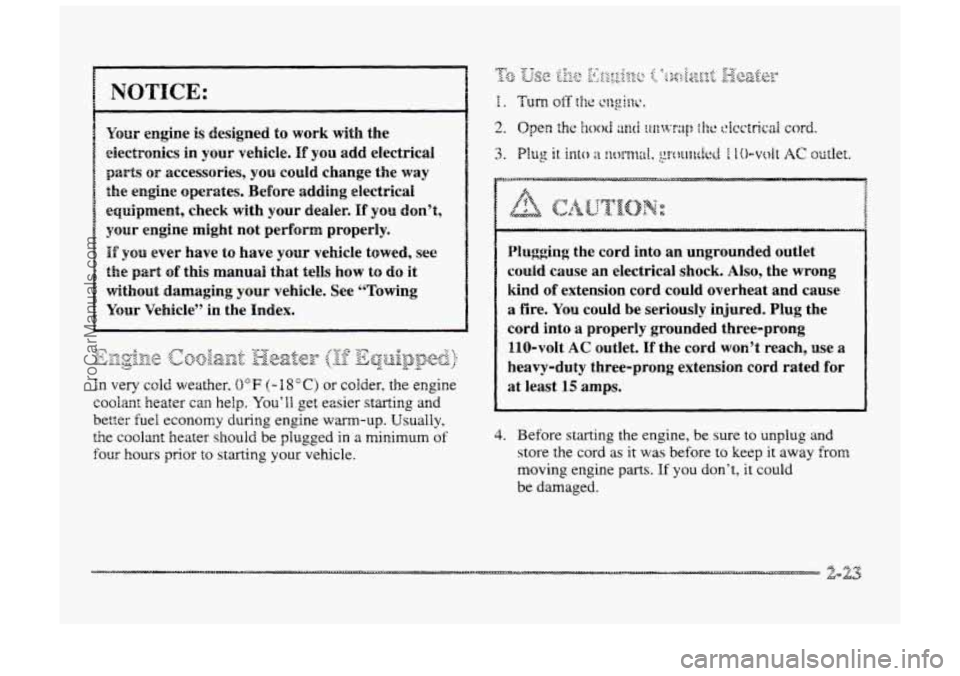
NOTICE:
Your engine is designed to work with the
electronics
in your vehicle. If you add electrical
parts OF accessories, you could change the way
the engine operates. Before adding electrical
equipment, check with your dealer.
If you don’t,
your engine might not perform properly.
If yon ever have to have your vehicle towed, see
the past of this manual that tells how to do it
without damaging your vehicle. See “Towing
Your Vehicle” in the Index.
In very cold weather, 0 OF (- I 8 O C) or colder, the engine
coolant
heater can he8p. You’ll get easier starting and
better fuel economy during engine wm-up. Usually,
the coolant heater should be plugged in a minimum of
four hours prior to starting your vehicle.
I_ -I
cigUTE[y%q @ -. .. b.8
Plugging t.he cord into an ungrounded outlet
could cause an electrical shock. Also, the wrong
kind of extension cord could overheat and cause
a fire. You could be seriously injured. Plug the
cord into
a properly grounded three-prong
110-volt
AC outlet. If the cord won’t reach, use a
heavy-duty three-prong extension cord rated for
at least
15 amps.
4. Before starting the engine, be sure to unplug and
store the cord as it was before to keep it away from
moving engine parts. If you don’t, it could
be damaged.
ProCarManuals.com
Page 90 of 426
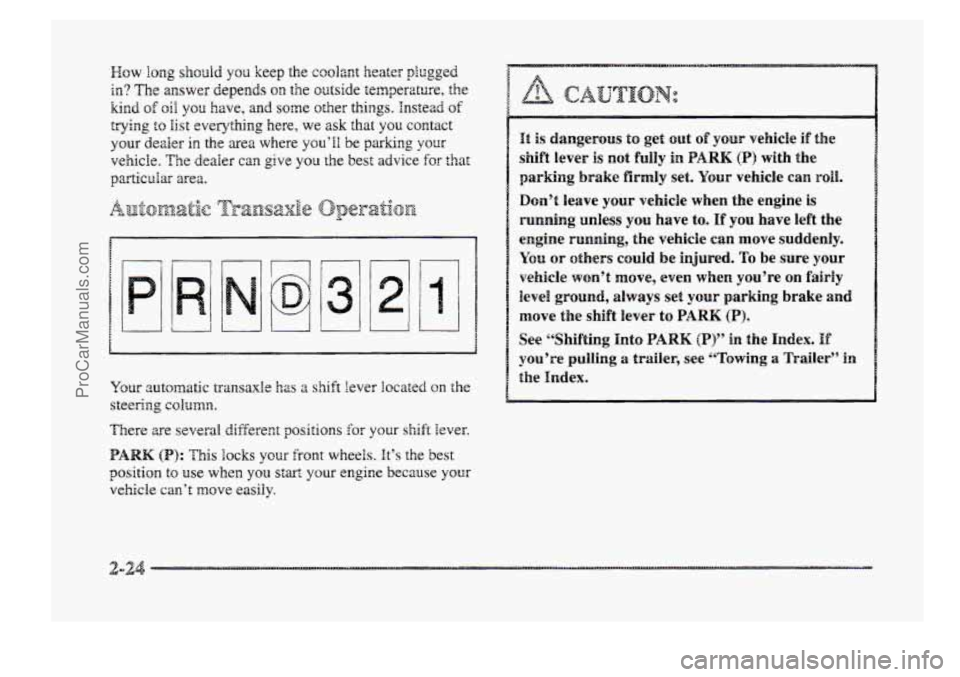
Wow long shodd YOU keep the coolant heater plugged
in? The answer depends on the outside temperature, the
kind of oil you have, and some other things. Instead of
trying t~ list everything here, we ask that you contact
your
dealer in the area where you’ll be parking pur
vehicle. The dealer cm give you the best advice for that
particdar area.
Y0mr automatic transaxle has a shift lever located on the
steering column.
There we several different positions for your shift lever.
PARK (PI: This Bocks your front wheels. It’s the best
position t~ we when YOU start your engine because pl~r
vehicle can’t move easily.
CAUTION:
I& is dangerous to get out of your vehick if the
shift lever is not fully in PARK (P) with the
parking brake firmly set.
Your vehicle can roll.
Don’t leave your vehicle when the engine is
running unless you have to. If you have left the
engine running, the vehicle can move suddenly.
You or others could be injured. TQ be sure your
vehicle won’t move, even when you’re on fairly
level ground, always set
y0w parking brake and
move the shift lever to PARK (P).
See ‘“Shifting Hnt~ PARK (P)” in the Index. If
you’re pulling a trailer, see “Towing a Trailer” in
the Index.
2-24
ProCarManuals.com
Page 91 of 426
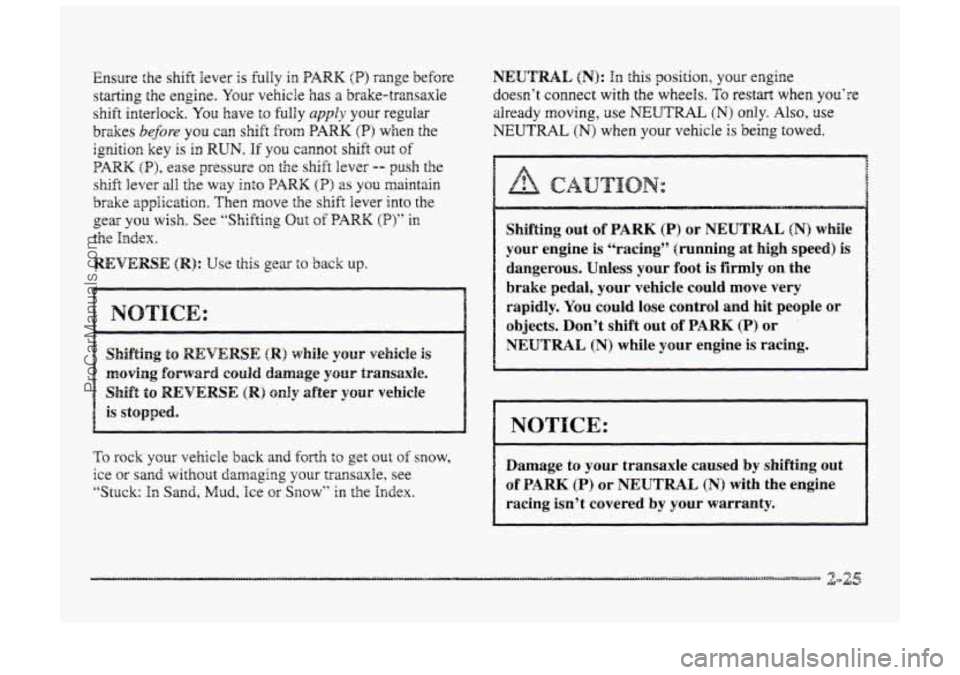
Ensure the shift lever is fuily in PARK (PI range before
starting the engine.
Your vehicle has a brake-transaxle
shift interlock.
You have to fully apply your regular
brzkes
before you can shift from PARK (P) when the
ignition key is in RUN. If you cannot shift out of
PARK (B), ease pressure on the shift lever -- push the
shift lever all the way into PARK (P) as you rnaintain
brake appiic~tion. Then move the shift lever into the
gear you wish. See “Shifting Out of PARK (E’)” in
the Index.
REVERSE (R): Use this gear to back up.
Shift to REVERSE (R) oanhy after vehicle
To rock your vehicle back and forth to get out of snow,
ice sand without damaging your transaxle, see
“Stuck:
In Sand, Mud, Ice or Snow” in the Index.
NEUTRAL (N): In this position, your engim
doesn’t connect with the wheels.
To restart when you’re
already
moving, use NEUTRAL (N) only. Also, use
NEUTRAL (N) when your vehicle is being towed.
Shifting out of PARK (P) or NEUTRAL fN) while
your engine is “racing” (running
at high speed) is
dangerous. Unless your foot is firmly on the
brake pedal, your vehicle could move very
rapidly. You could lose control and hit people
or
objects. Don’t shift out of PARK (P) or
NEUTRAL (N) while your engine is racing.
1 NOTICE:
Damage to your transaxle caused by shifting out
of PARK (P) or NEUTRAL (N) with the engine
racing isn’t covered by your warranty.
ProCarManuals.com
Page 92 of 426
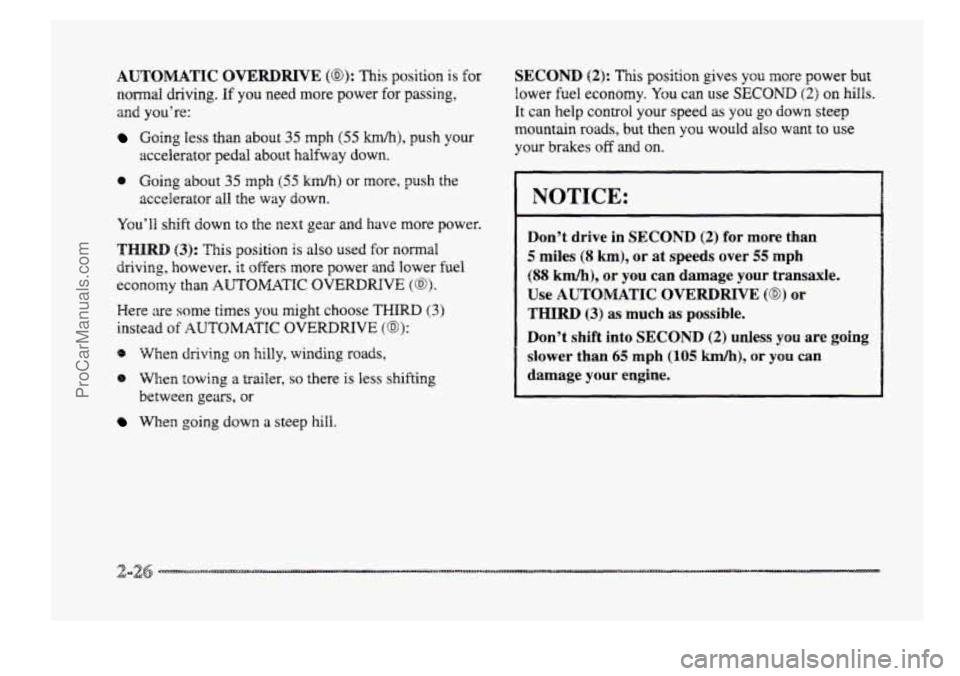
AUTOMATIC OVERDRIVE (@):This positionis for
normal driving. Pf you need more power for passing,
and you’re:
Going less than about 35 mph (55 kmh), push your
accelerator pedal about halfway down.
e Going about 35 mph (55 kmh) or more, push the
accelerator
all the way down.
You’U shift down to the next gear and have more power.
THIRD (3): This position is also used for normal
driving, however, it offers more power and Bower fuel
economy than AUTOMATIC OVERDRIVE (0).
Here are some times you might choose THIRD (3)
instead of AUTOMATIC OVERDRIVE (a):
Qb When towing a trailer, so there is less shifting
between gears,
or
SECQND (2): This position gives you nore power but
lower fuel economy. YQU can use SECOND (2) on hills.
It can help control your speed as you go down steep
mountain roads, but
then you would also want to use
your
brakes off and on.
NOTICE:
Don’t drive in SECOND (2) for more than
5 miles (8 km), or at speeds over 55 mph
(88 km/h), or you can damage your transaxle.
Use AUTOMATIC OVERDRIVE (0) or
THIRD (3) as much as possible.
Don’t shift into SECOND
(2) unless you are going
slower than
65 mph (105 km/h), or you can
damage your engine.
When going down a steep hill.
ProCarManuals.com
Page 94 of 426
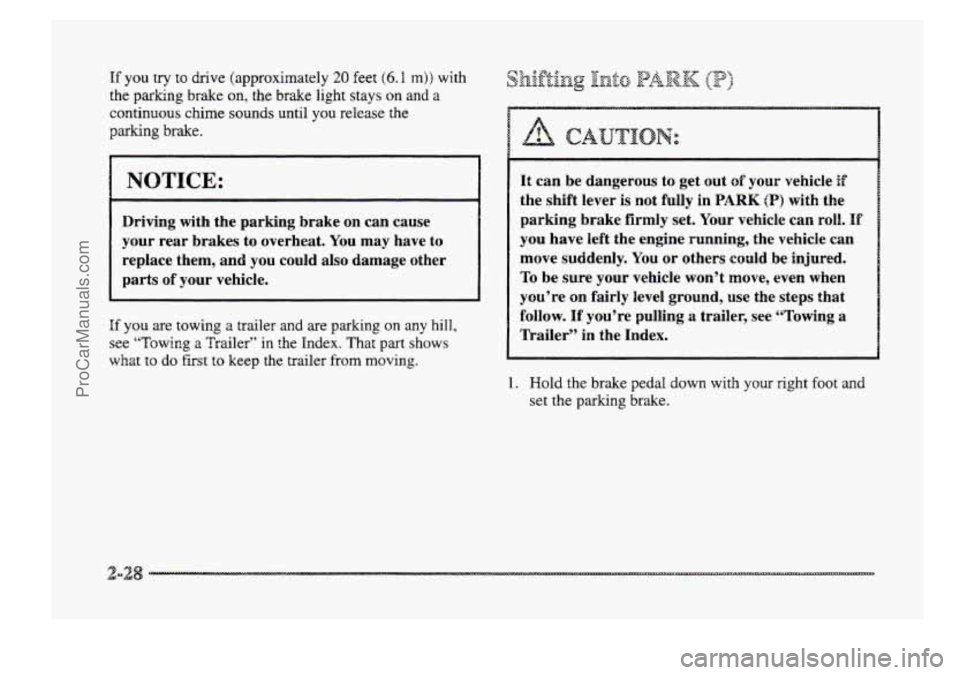
If you try to drive (approximately 20 feet (6.9 m)) with
the
parlkrng brake on, the brake light stays on and a
continuous chime sounds until you release the
parking
brake.
NOTICE:
Driving with the parking brake on can cause
your rear brakes to overheat. You may have to
replace them, and you could also damage other
parts
of your vehicle.
If you are towing a trailer and are parking on any hill,
see “Towing a Trailer” in the Index. That part shows
what
to do first to keep the trailer from moving.
It can be dangerous to get out of your vehicle if
the shift lever is not fully in PARK (P) with the
parking brake firmly set. Your vehicle can roll.
If
you have left the engine running, the vehicle can
move suddenly. You or others
could be injured.
To be sure your vehicle won’t move, even when
you’re on fairly level ground,
use the steps that
follow.
If you’re pulling a trailer, see “Towing a
Trailer” in the Index.
1. Hold the brake pedal down with your right foot and
set the parking brake.
ProCarManuals.com